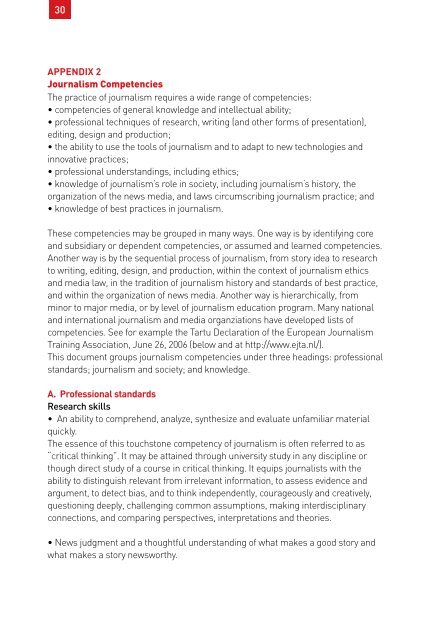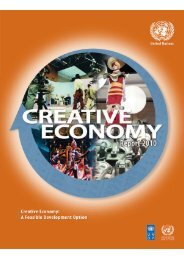Model curricula for journalism education for developing countries ...
Model curricula for journalism education for developing countries ...
Model curricula for journalism education for developing countries ...
Create successful ePaper yourself
Turn your PDF publications into a flip-book with our unique Google optimized e-Paper software.
30<br />
APPENDIX 2<br />
Journalism Competencies<br />
The practice of <strong>journalism</strong> requires a wide range of competencies:<br />
• competencies of general knowledge and intellectual ability;<br />
• professional techniques of research, writing (and other <strong>for</strong>ms of presentation),<br />
editing, design and production;<br />
• the ability to use the tools of <strong>journalism</strong> and to adapt to new technologies and<br />
innovative practices;<br />
• professional understandings, including ethics;<br />
• knowledge of <strong>journalism</strong>’s role in society, including <strong>journalism</strong>’s history, the<br />
organization of the news media, and laws circumscribing <strong>journalism</strong> practice; and<br />
• knowledge of best practices in <strong>journalism</strong>.<br />
These competencies may be grouped in many ways. One way is by identifying core<br />
and subsidiary or dependent competencies, or assumed and learned competencies.<br />
Another way is by the sequential process of <strong>journalism</strong>, from story idea to research<br />
to writing, editing, design, and production, within the context of <strong>journalism</strong> ethics<br />
and media law, in the tradition of <strong>journalism</strong> history and standards of best practice,<br />
and within the organization of news media. Another way is hierarchically, from<br />
minor to major media, or by level of <strong>journalism</strong> <strong>education</strong> program. Many national<br />
and international <strong>journalism</strong> and media organziations have developed lists of<br />
competencies. See <strong>for</strong> example the Tartu Declaration of the European Journalism<br />
Training Association, June 26, 2006 (below and at http://www.ejta.nl/).<br />
This document groups <strong>journalism</strong> competencies under three headings: professional<br />
standards; <strong>journalism</strong> and society; and knowledge.<br />
A. Professional standards<br />
Research skills<br />
• An ability to comprehend, analyze, synthesize and evaluate unfamiliar material<br />
quickly.<br />
The essence of this touchstone competency of <strong>journalism</strong> is often referred to as<br />
“critical thinking”. It may be attained through university study in any discipline or<br />
though direct study of a course in critical thinking. It equips journalists with the<br />
ability to distinguish relevant from irrelevant in<strong>for</strong>mation, to assess evidence and<br />
argument, to detect bias, and to think independently, courageously and creatively,<br />
questioning deeply, challenging common assumptions, making interdisciplinary<br />
connections, and comparing perspectives, interpretations and theories.<br />
• News judgment and a thoughtful understanding of what makes a good story and<br />
what makes a story newsworthy.

















